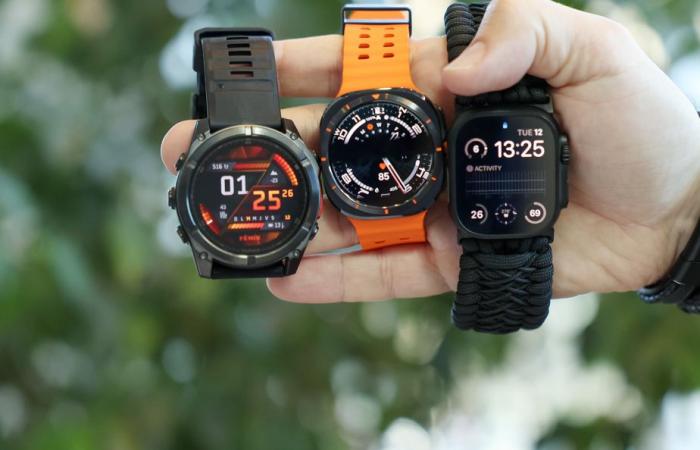There is a market for overpriced watches. Not to mention Audemars Piguet or Vacheron Constantin… These are connected watches for athletes keen to microcalculate their physical efforts, such as the Apple Watch Ultra, the Garmin Fénix 8 and the Samsung Galaxy Watch Ultra, for which the ( other) superlatives abound.
Published at 6:00 a.m.
These “ultrawatches” are designed to tackle the roughest trails and the most arduous sporting challenges. They must be extremely precise, super reliable while remaining hyper connected. They have no room for error. Neither does the buyer, given their price… ultra-high.
Apple Watch Ultra 2
Connected watch first, sporty second, the Apple Watch Ultra sets the tone. Its second generation launched in fall 2023 only changed cosmetically this year, with a black titanium case as an option from gray. Its 49mm OLED display is square, with rounded corners. It has 3000 nits of brightness, making it readable even in direct sunlight. Three bracelets are offered free of charge, many others are sold separately. The device pairs exclusively with an iPhone via Bluetooth, can connect to WiFi networks, and can then operate alone, via a 4G LTE connection. Its GPS antenna is dual frequency, which increases the precision of its geolocation. It costs $1099.
Apple promises 36 hours of normal usage, 28 hours in LTE mode, and 72 hours in an ultra-low power saving mode. This drops to between 12 and 35 hours if you activate its sensors to record an outdoor sporting activity, for example, an ultramarathon. The watch meets standards like MIL-STD 810H and WR100, which certify that it withstands a host of harsh conditions, including diving to 500 meters below sea level, or climbing to 9,000 meters above sea level. altitude (good luck with that).
Purchasing this watch is justified if you already have an iPhone that you want to use during an outdoor outing. Its connectivity and the fluidity of its software interface are impeccable, especially if you use other Apple services, like Apple Music and Apple Pay. Off-road, its satellite messaging is reassuring. Its siren and its monitoring of your hikes too.
He lacks more autonomy. And compatibility with Android? (O sacrilege!)
Garmin Fenix 8
The Fénix 8 is the ultimate Garmin connected watch. Its price is appropriate: from $1350 to $1620, depending on its size, from 43 to 51 mm. It includes a microphone and a speaker, ANT, Bluetooth and WiFi antennas, and a modest application store to manage most of its communications, store more than 24 GB of MP3 files or pay with a payment card. It can go 100 meters underwater. It has a dual frequency GPS antenna. It includes a small LED flashlight on the front, very useful from 4 p.m. on the trails these days.
Its AMOLED touch screen is bright. Its 14-day battery life without straining is exceptional (fortunately, because its charger is painful to connect). There is a solar-charging version. You can personalize your interface a little and change your bracelet as you wish.
The Fénix 8 captures and then displays lots and lots of data on around a hundred sporting activities, which can be combined to create tailor-made multi-sport programs. Its biggest flaw: you have to press too many buttons too often to access the desired screens, applications or data. It makes you sweat.
Samsung Galaxy Watch Ultra
As you can guess from its name, the Galaxy Watch Ultra imitates the Apple Watch Ultra, right down to the obligation to pair it with a phone of the same brand to get the most out of it. It has limited compatibility with other Android devices, although it uses Google’s Wear OS. Missed opportunity. At least it inherits the application store of this system, very solid, which goes hand in hand with Android.
The Galaxy Watch’s three-color case frames a round 47mm Super AMOLED dial. The watch accomplishes essentially the same technical feats as its Apple rival, despite its immersion limit of “only” 100 meters. Spotify, Google or Samsung Pay, Outlook and other apps make it an outstanding connected accessory, via Bluetooth, WiFi or LTE. Its autonomy is longer than that of the Apple Watch by around ten hours. Its bracelets have a unique connector that prevents them from simply being replaced.
Its interface is efficient, even if a fully functional crown had done better than a third button. Another opportunity missed by Samsung. At $880, it doesn’t have the refinement of the Watch Ultra, but it has everything else. Or almost: it too would have deserved better interoperability.






